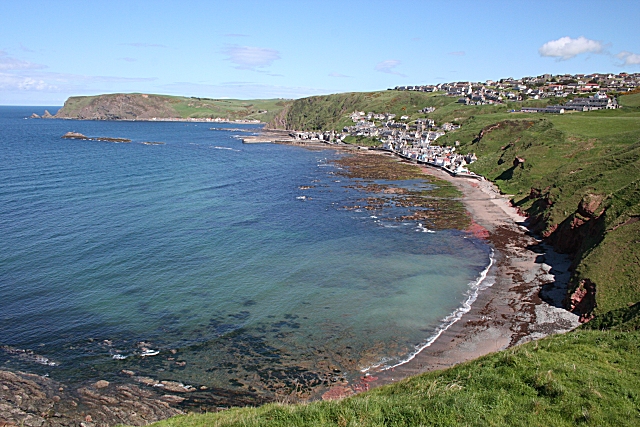Black Craig
Island in Banffshire
Scotland
Black Craig

Black Craig is a small island located off the coast of Banffshire, Scotland. It is situated in the North Sea, approximately 3 miles east of the town of Portsoy. The island is known for its unique geological features and diverse wildlife.
At just 30 meters in height, Black Craig is a relatively small island measuring approximately 500 meters in length and 200 meters in width. Its rugged cliffs and rocky shoreline make it a popular destination for birdwatchers and nature enthusiasts. The island is home to a variety of seabirds including razorbills, guillemots, and puffins, which can be observed nesting in the cliffs during the breeding season.
The island's geology is of particular interest, as it is composed of Old Red Sandstone, a sedimentary rock formation that dates back over 400 million years. The sandstone cliffs on Black Craig exhibit unique patterns and colors, providing a stunning backdrop for photography and exploration.
Access to Black Craig is limited due to its remote location and lack of amenities. Visitors looking to explore the island are advised to hire local boat services or participate in guided tours that depart from nearby ports. It is essential to respect the island's fragile ecosystem and wildlife, ensuring that no harm is caused to the natural environment.
Black Craig is a hidden gem in the Banffshire region, offering a tranquil escape for those seeking rugged beauty and a unique geological experience.
If you have any feedback on the listing, please let us know in the comments section below.
Black Craig Images
Images are sourced within 2km of 57.670177/-2.3843071 or Grid Reference NJ7764. Thanks to Geograph Open Source API. All images are credited.




Black Craig is located at Grid Ref: NJ7764 (Lat: 57.670177, Lng: -2.3843071)
Unitary Authority: Aberdeenshire
Police Authority: North East
What 3 Words
///noun.oven.anthems. Near Macduff, Aberdeenshire
Nearby Locations
Related Wikis
St John's Church, Gamrie
St John's Church is a ruined church and kirkyard in the parish of Gamrie, Aberdeenshire, Scotland. The church, dedicated to St John the Evangelist, was...
Cairn Lee
Cairn Lee is a prehistoric monument in Aberdeenshire, Scotland. Cairn Lee and proximate Longman Hill are the oldest prehistoric features in the local area...
Gardenstown
Gardenstown (Scots: Gamrie) is a small coastal village, 8.7 miles (14.0 km) by road east of Banff in Aberdeenshire, northeastern Scotland. The village...
Gamrie Bay
Gamrie Bay is a bay in Aberdeenshire, Scotland. The bay is between Crovie Head and More Head. The villages of Gardenstown and Crovie are located within...
Have you been to Black Craig?
Leave your review of Black Craig below (or comments, questions and feedback).
















